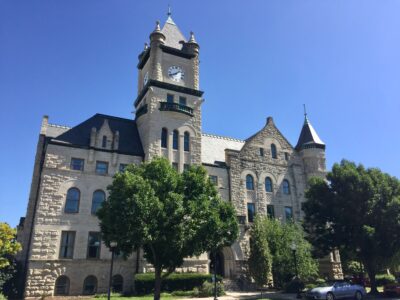Douglas County’s behavioral health crisis center could be partially open within weeks, according to newly released timeline

photo by: Kim Callahan/Journal-World
The Treatment and Recovery Center of Douglas County is pictured on Saturday, Oct. 22, 2022.
Story updated at 8:30 p.m. Wednesday, March 22:
Although Douglas County leaders have yet to officially decide who will operate the county’s yet-to-open behavioral health crisis center, the plan is for it to be partially open in a matter of weeks.
That’s according to information about the Treatment and Recovery Center of Douglas County that county staff shared during Wednesday’s Douglas County Commission meeting. The presentation included a timeline for opening that lists April 10 as the date when the facility will begin partial operations via a front-of-house urgent care unit, which has also previously been referred to as an “access center.”
The timeline lists May 25 as the target date when the other portion of the facility — an observation and stabilization unit that can accommodate patients who need to stay for 23 to 72 hours — would begin operating at partial capacity. Two more dates on the timeline, July 17 and Oct. 7, are listed as targets for increasing the unit’s patient capacity in two further steps.
The county is currently negotiating with Bert Nash Community Mental Health Center about possibly operating the facility; those talks have been ongoing since Bert Nash first expressed an interest in serving in that role in December.
Although it’s still not been determined whether Bert Nash will be the entity running the TRC, Bert Nash CEO Patrick Schmitz told commissioners Wednesday night that he’s confident the timeline is achievable.
“We are confident in those dates, and those are in discussion with county staff and informed by the team that will be there every day doing this work,” Schmitz said.
At the beginning of the presentation, Douglas County Administrator Sarah Plinsky noted that “no decisions have been made and no agreements have been reached” yet regarding the center’s operations, and any future action will be taken by commissioners at an upcoming public meeting.
But the final decision about who’s going to be running the facility also seems to be just around the corner. The county’s self-imposed deadline for putting together an operating agreement and lease in their final forms is March 31, and those agreements are supposed to go to the commission for a vote at its April 5 meeting. Plinsky told commissioners she’s optimistic that the county will be able to stick to that timeline, too.
“I think we’re on this timeline,” Plinsky told commissioners. “I think we’re making progress towards meeting these deliverables. I don’t like to make promises I can’t necessarily keep, but I think we’re making substantial progress to meet these timelines.”
• • •
During the presentation, the county’s director of behavioral health projects, Bob Tryanski, outlined a detailed list of functions that would be active during each phase of the TRC’s opening. From the first day of the partial opening, for example, the facility’s urgent care unit would be ready to receive walk-ins seven days a week, from 8 a.m. to 8 p.m. on weekdays and from 10 a.m. to 4 p.m. on weekends. Patients would be able to see a provider within an hour of arriving, and they would be able to return to the TRC for interim care as needed in follow-up appointments.
During that phase, Tryanski said Bert Nash would be able to complete intakes at the TRC and would be expected to have a mechanism in place to track follow-up appointments. Bert Nash would also track and provide monthly data reports to the county about patient contacts, according to the presentation.
In the second phase, the facility would be open 24/7, with the observation and stabilization unit ready to receive voluntary patients and referrals from LMH Health’s emergency department, Bert Nash’s mobile crisis response team and Lawrence Police Department responders.
That unit would start out with a capacity of five to 10 patients, then move to a capacity of 16 within the first 90 days after opening. Its capacity could increase to 24 within the first six months, though Tryanski said the actual number should probably be implemented based on patient volumes in consultation with the county.
The presentation also included a list of targets that should be achieved within those first six months, such as convening a TRC Advisory Council to provide consumer input, feedback, public education and accountability. Tryanski said the center will also be aiming for a first responder drop-off acceptance rate of more than 90% and a turnaround time of less than 10 minutes for accepting patients at the building’s side entrance that will serve as an intake checkpoint for the observation and stabilization unit.
Brooke Aziere, a partner with Kansas-based law firm Foulston Siefkin LLP who is serving as the county’s outside legal counsel, was also at Wednesday’s meeting, and she told commissioners about the status of the “due diligence” items the county and Bert Nash have been working on during the past few months. According to the presentation, nine of the 16 due diligence items listed — including things like insurance and workflow documents — are listed as either “complete” or “substantially complete.” The remaining items, including a budget, are all still in progress, but in many cases Aziere said that progress has been substantial.





